Photonic spin Hall effect and terahertz gas sensor via InSb-supported long-range surface plasmon resonance
2022-01-23JieCheng程杰GaojunWang王高俊PengDong董鹏DapengLiu刘大鹏
Jie Cheng(程杰) Gaojun Wang(王高俊) Peng Dong(董鹏) Dapeng Liu(刘大鹏)
Fengfeng Chi(迟逢逢)1, and Shengli Liu(刘胜利)1
1School of Science,New Energy Technology Engineering Laboratory of Jiangsu Province,Nanjing University of Posts and Telecommunications,Nanjing 210023,China
2College of Electronic and Optical Engineering&College of Microelectronics,Nanjing University of Posts and Telecommunications,Nanjing 210023,China
Keywords: surface plasmon resonance,photonic spin Hall effect,InSb,gas sensor
1. Introduction
Photonic spin Hall effect (SHE) is an interesting phenomenon in which the left- and right-circular components shift transversely perpendicular to the refractive index gradient when a light beam propagates through an inhomogeneous medium.[1-3]It is an optical version of SHE in electronic systems,where the roles of the spin photons and refractive index gradient are similar to spin electrons and electric potential,respectively.[1,3]This transverse shift is also called Imbert-Fedorov (IF) shift as it was theoretically predicted by Fedorov and experimentally confirmed by Imbert.[4,5]Generally,the inherent physical mechanism of photonic SHE is believed to be an effective spin-orbit interaction of photons based on the fundamental law of angular momentum conservation.[6,7]Owing to its enormous potential applications in precision metrology and quantum information technology, photonic SHE has attracted increasing attention since its discovery.[8,9]It has also been adopted to identify the layer numbers of graphene,[10]to realize the real-time detection of dynamic chemical reaction,[11]to apply for the optical differential operation and edge detection.[12]Recently,the optical sensor based on the photonic SHE has been proposed.[13-16]However,photonic SHE is a weak effect whose spin-dependent transverse splitting is usually limited to the subwavelength scale. Therefore, it cannot be directly observed with conventional experimental methods, and the successful detection must be incorporated with quantum weak measurements.[17]To facilitate its application,enhancing the photonic SHE has become very significant.
In recent years,several methods and novel materials have been proposed to enhance the photonic SHE, including the Brewster angle,[18]resonant optical tunneling effect,[19]optical pumping,[20]exceptional points in parity-time symmetric systems,[21]two-dimensional atomic crystals[22]and so on. Moreover, surface plasmon resonance (SPR)[23,24]is an effective way to improve the photonic SHE.[15,25-27]For example, Zhouet al.presented the enhanced photonic SHE in a simple glass-metal-air structure.[25]Nevertheless, conventional surface plasmon polariton(SPP)is always characterized by the strong absorption loss, inadequate propagation length and shallow penetration depth, which may be detrimental to its further applications. Long-range surface plasmon polariton (LRSPP) is a coupling mode of two SPPs, and it has been demonstrated to have lower loss, narrower angular resonance curves,longer propagation length and greater penetration depth. Based on these advantages,the long-range surface plasmon resonance(LRSPR)has the potential to enhance the photonic SHE. Recently, Tanet al.reported that by exciting the LRSPP in a prism-silica-gold-silica structure, the largest spin shift with a 632.8 nm incident Gaussian beam can reach 7.85 µm,[28]which is about 3.5 times larger than the value in conventional SPR configurations.[25]Note that previous reports have focused on the enhancement of photonic SHE in the visible range based on the excitation of SPP by metals;however,inadequate attentions are paid to the terahertz range.Therefore, investigating the photonic SHE by taking advantage of the LRSPR effect in the terahertz range is highly desirable.
The first and most urgent challenge is to look for suitable materials instead of metals for the excitation and tunneling of terahertz SPPs. Alternative materials can be the semiconductors,whose permittivities in the terahertz region are similar to those of metals in the visible region. Among them, InSb is a semiconductor with a very small energy gap of 0.17 eV and a very large electronic mobility~7.7×104cm2·V-1·s-1.[29]In particular, its permittivity can be dynamically tuned by varying the temperature.[30-32]Therefore,InSb is a good candidate to construct the LRSPR configuration in the terahertz region,and the photonic SHE of this InSb-based structure could be flexibly controlled by the temperature.
Epsilon-near-zero (ENZ) metamaterial is a special kind of artificial medium in which the permittivity is close to zero.The enhanced photonic SHE of both transmitted and reflected light can be obtained in a thin ENZ slab.[33,34]In this paper, ENZ material is adopted to be the dielectric layer, and with regard to the requirement of LRSPR effect, InSb material should be surrounded by these two ENZ layers to realize the coupling of two SPPs. We present the significant enhancement of photonic SHE for this InSb-based LRSPR structure in the terahertz region. Under the optimal structural parameters and temperature, the maximum spin shift is found to be 2.68 mm. Finally, the terahertz gas sensor based on the photonic SHE is proposed with a superior intensity sensitivity of 2.5×105µm/RIU.Our research is important for providing an effective way to enhance the photonic SHE in the terahertz region and may offer the opportunity to develop the terahertz sensors based on the photonic SHE.
2. Theory and model
A multilayer symmetric structure composed of air, InSb and ENZ slab is proposed in Fig. 1. The incident light is a Gaussian beam whose frequency is 1 THz with the beam waist of 30λ. For simplicity, the thickness of the ENZ layer and InSb are defined asd2andd3, respectively. The relative dielectric constant of the ENZ slab is set to be 0.01.[33,34]The permittivity of the InSb semiconductor can be described well by the following Drude model:[35]



Therefore the permittivity of InSb can be effectively tuned by temperature, and firstly the temperature is taken to be 300 K in the following discussion.
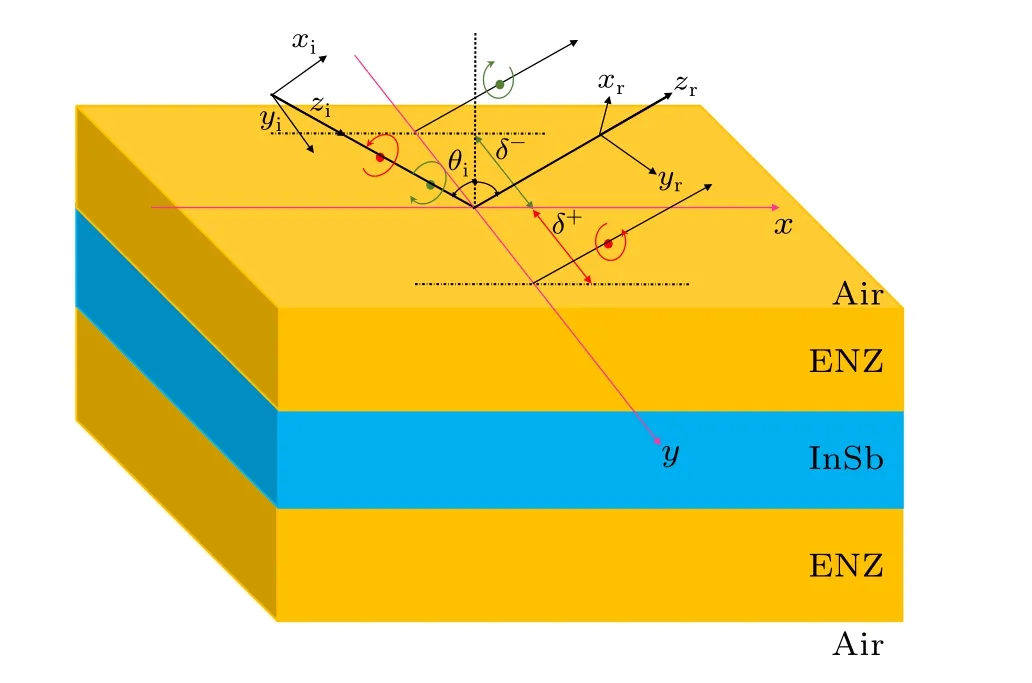
Fig.1. Schematic of the photonic SHE in the multilayer LRSPR structure of air-ENZ-InSb-ENZ-air. δ+andδ-denote the transverse shifts of left- and right-circularly polarized light beam centroid,respectively.
A monochromatic Gaussian beam is incident from the air to the surface of the multilayer structure with an incident angleθi, and the photonic SHE of reflected light occurs due to the excitation of LRSPR,manifesting itself as the opposite shifts of the left-and right-circularly polarized light. In our configuration of Fig.1,the incident plane isx-zand the spin shift is along they-axis. We consider an incident Gaussian beam with angular spectrum of
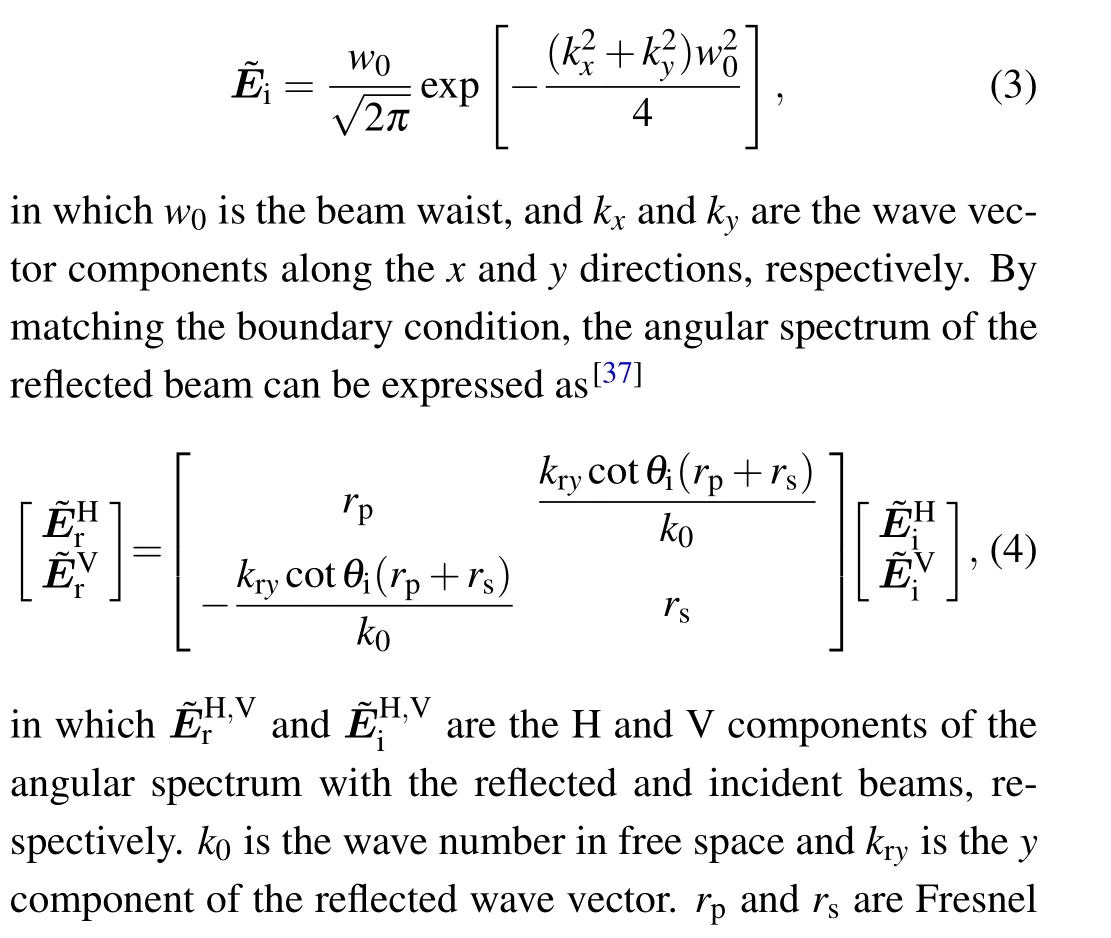

3. Results and discussion
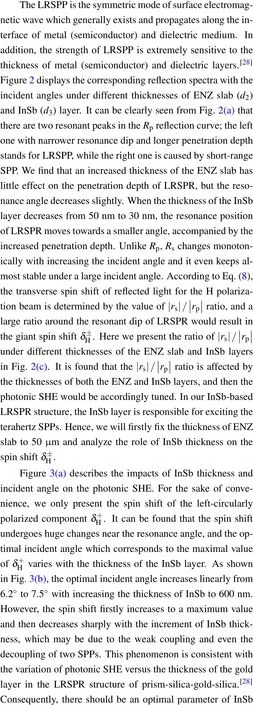

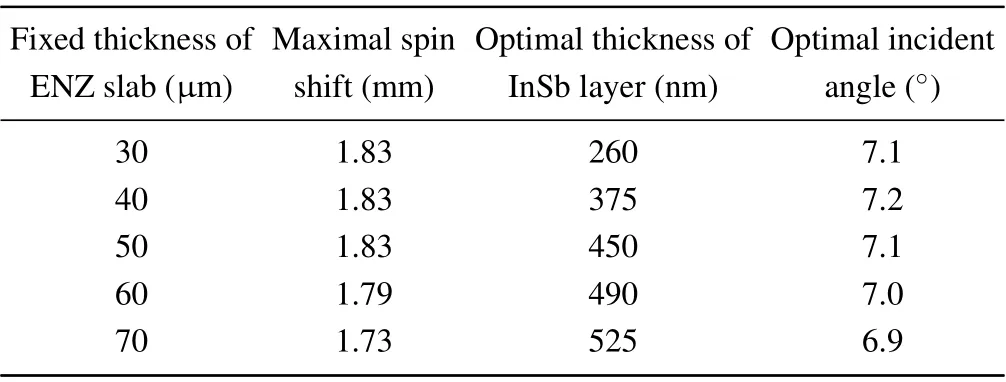
Table 1. The maximum values of spin shifts,as well as the optimal incident angle and the thickness of ENZ and InSb layers.

Fig. 2. Impact of the thickness of the ENZ slab and InSb layer on the reflectance (a) Rp =2, (b) Rs =|rs|2 and (c) the ratio |rs|/under the condition of LRSPR.
Note that the above discussions are based on the ENZ slab thickness of 50µm. To study the influence of the thickness of the ENZ layer on the photonic SHE,we choose other values of ENZ layer thickness(i.e.,30µm,40µm,60µm,and 70µm).The maximal spin shifts,as well as the corresponding incident angle and the optimal thickness of the InSb layer,are given in Table 1. For different ENZ layer thicknesses,the optimal incident and optimal InSb thickness vary,and consequently different enhancements of photonic SHE are achieved. It is clearly seen that, as the thickness of ENZ slab varies from 30 µm to 50 µm, the maximum value of spin shift is almost stable(~1.83 mm). As the ENZ layer thickness keeps increasing(60µm and 70µm),the maximal spin shift decreases sharply.Therefore,the photonic SHE is affected by the thicknesses of both the ENZ layer and InSb layer,and the optimal parameter setup is found to generate the largest spin shift.
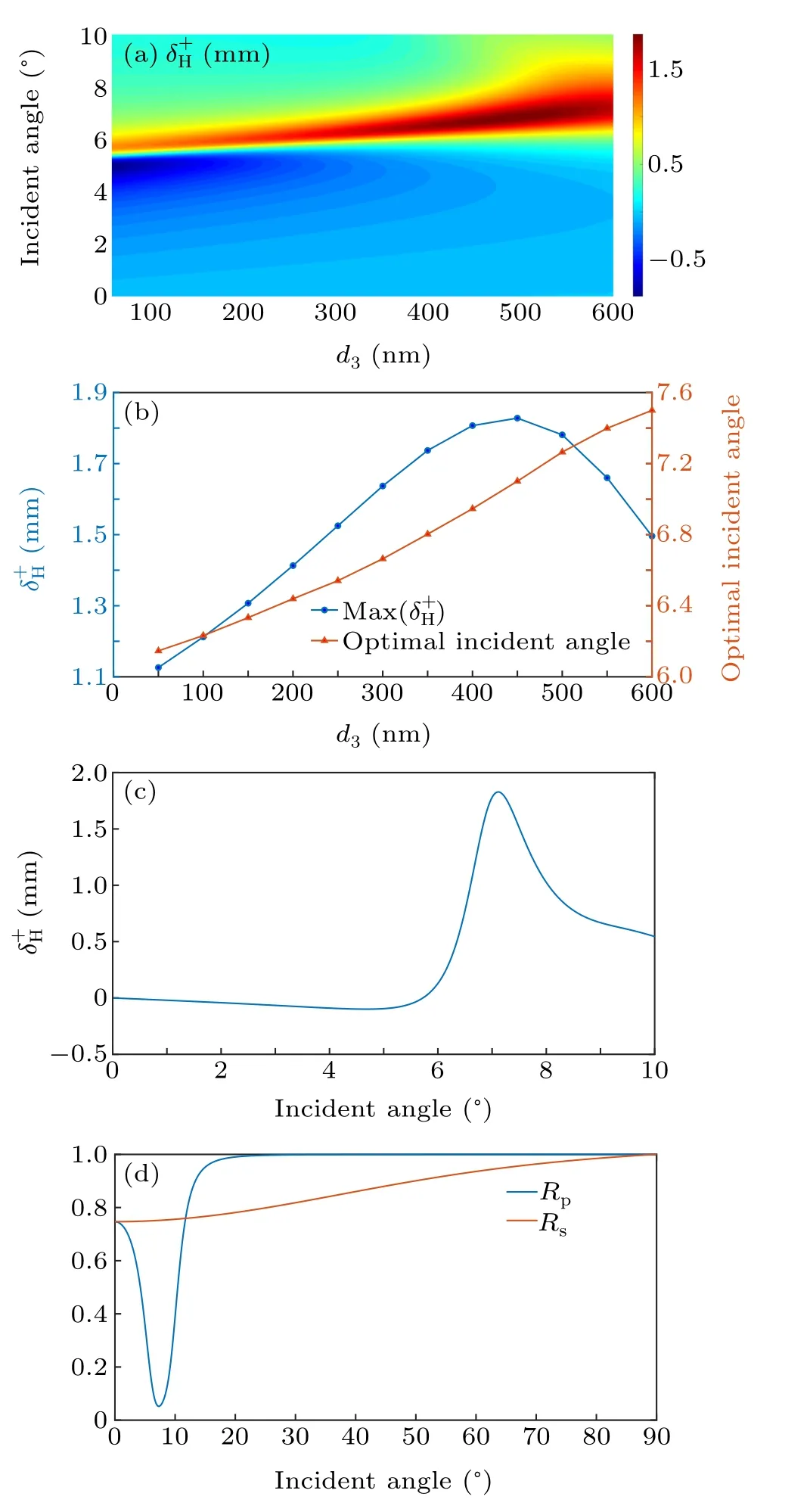
Fig.3. (a)Spin shifts as functions of the InSb thickness and incident angle.(b) The maximal spin shift δ+H and optimal incident angle varying with the thickness of InSb layer. (c) Largest spin shift δ+H. (d) The corresponding reflection spectra under optimal conditions.

Fig.4. (a)The permittivity of InSb for different temperatures at 1 THz. (b)Variations of the minimum value of Rp and corresponding incident angle with the temperature.(c)The spin shift δ+H versus the incident angle with different temperatures. Here d2=50µm and d3=450 nm.
Considering Eq. (1), temperature is a tunable parameter to control the permittivity of InSb,and therefore the behavior of photonic SHE would be accordingly modulated by temperature.The dependence of InSb permittivity on the temperature at 1 THz is shown in Fig.4(a). It can be seen that both the real and imaginary parts of InSb permittivity stabilize to be a tiny value when the temperature is smaller than 260 K.As the temperature continues to increase,the real term becomes negative and the imaginary one increases to be a large positive value.In order to explore the influence of temperature on LRSPP,we provide the relationship between the minimum value ofRpand the corresponding resonant angle with different temperatures in Fig.4(b). It is demonstrated that the minimum value ofRpchanges slightly at low temperature,owing to the stable behavior of InSb permittivity. Then it undergoes the rapid increase with increasing the temperature. For example, the minimum value ofRpincreases to 0.66 at 400 K, which may indicate the decoupling of two SPPs at high temperature. However,the corresponding resonant angle(i.e.,incident angle at Min(Rp))increases to a maximum value of 7.3°at about 315 K and then decreases with the high temperature. Figure 4(c)displays the effect of temperature on the spin shift.It is pointed out that the maximum value of spin shift can be flexibly controlled by the temperature,accompanied by the variation of the optimal incident angle. There is an optimal temperature to obtain the giant spin shift around the resonance angle of LRSPR.The optimal temperature is about 300 K under the incident angle of 6.9°when the thickness of ENZ slab and InSb layer are 50µm and 450 nm,respectively. Consequently,temperature can be used as a tuning factor for photonic SHE, and to achieve the giant spin shift, the incident angle should be accordingly changed with temperature in the practical application of photonic devices.
According to the Eq. (8), the beam waist would affect the value of spin shifts. Hence the influence of beam waist on the tunability of spin shifts has also been investigated, as illustrated in Fig. 5. It is clearly seen that the spin shift increases with the increase of beam waist. For example, if we fix the beam waist of 30λ, the maximum spin shift is about 1.83 mm. When the beam waist equals 90λ, the maximum value of 2.50 mm can be obtained. However, when we continue to increase the beam waist, which is much larger than the incident wavelength, the effect of the beam waist on the photonic SHE becomes relatively weak.Under the optimal parameter setup,the maximum spin shift with a 1 THz incident beam reaches 2.68 mm, which is about 340 times larger than the spin shift induced by LRSPR for the incident wavelength of 632.8 nm.[28]
As a unique physical mechanism, the SPR effect has taken a renowned position in the field of sensing technology.In recent years, SPR sensing methodology has supported a wide range of applications in the fields of food safety, drug testing, medical analysis, environmental monitoring and so on.[38-40]Until now, most SPR-based sensors have been focused in the visible and infrared ranges by using the conventional noble metals like gold and silver. The research into terahertz sensors remains at the initial stage, although the combination of terahertz plasmonics and the high sensitivity of SPR holds great promise in terahertz sensing. Recently,Purkayasthaet al.proposed a SPR-based sensor in terahertz frequency using a free-standing doped graphene monolayer,and this sensor shows ultrahigh sensitivity of 34.11°/RIU along with an ultrahigh figure of merit.[41]A terahertz sensor based on a graphene-Bragg reflector composite structure is designed, and the maximal sensitivity of 407.36°/RIU is obtained.[42]In fact,the terahertz gas sensor still has great potential because the vibrational and rotational energy of most gas molecules lie in the terahertz range. Here, we propose a terahertz gas sensor based on photonic SHE induced by the excitation of InSb-supported LRSPP. Therein, the lowest air layer in Fig.1 can be replaced to fill the sensing gas molecules.According to the intensity-based shift sensing scheme, the gas sensor is conducted by setting a fixed working angle as shown in Fig. 6. The intensity sensitivity can be defined asSδ+H= Δδ+H/Δng, where Δδ+His the difference of spin shift caused by a refractive index change of gas Δng. We find that the spin shift of photonic SHE is very sensitive to the refractive index variation of gas, and a high intensity sensitivity of 2.5×105µm/RIU can be obtained, which is about 38 times higher than that of the metal SPR structure.[15]It should be noted that in our work the initial spin shift is applied to calculate the sensing sensitivity without any amplification technique. Nevertheless, its sensitivity is 2.5 times larger than that of a photonic SHE-based sensor using a signal enhancement method of weak measurement.[16]Therefore the proposed structure shows a superior sensing performance,and the gas sensor has potential applications in toxic monitoring,explosive detection and pollution control.

Fig. 5. The spin shift versus the incident angle with different beam waists.Here d2=50µm and d3=450 nm.

Fig. 6. The intensity sensitivity for the gas sensor of InSb-based LRSPR structure.
4. Conclusion
In summary, we have reported the enhanced photonic SHE in the terahertz range while the InSb-supported LRSPR is excited. The thickness of the InSb layer has a major impact on the value of spin shift. In view of the intimate relationship between optical properties of InSb and temperature,the spin shift can be dynamically tuned by temperature. Under the condition of optimal parameters,the giant spin shift of 2.68 mm is generated. Finally,the spin shift is quite sensitive to the refractive index changes of measured gases. Therefore,the proposed LRSPR structure can be applied to the design of the terahertz gas sensor, and the intensity sensitivity is about 2.5×105µm/RIU, demonstrating a superior sensing performance. Our research provides a significant design guide for developing terahertz nanophotonic devices based on the LRSPR effect.
Acknowledgments
Project supported by the National Natural Science Foundation of China(NSFC)(Grant No.12175107),Open Project of National Laboratory of Solid State Microstructures of Nanjing University(Grant No.M32022),and the Natural Science Foundation of Nanjing University of Posts and Telecommunications(Grant No.NY220030).
猜你喜欢
杂志排行
Chinese Physics B的其它文章
- Superconductivity in octagraphene
- Soliton molecules and asymmetric solitons of the extended Lax equation via velocity resonance
- Theoretical study of(e,2e)triple differential cross sections of pyrimidine and tetrahydrofurfuryl alcohol molecules using multi-center distorted-wave method
- Protection of entanglement between two V-atoms in a multi-cavity coupling system
- Semi-quantum private comparison protocol of size relation with d-dimensional GHZ states
- Probing the magnetization switching with in-plane magnetic anisotropy through field-modified magnetoresistance measurement
